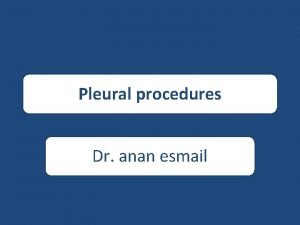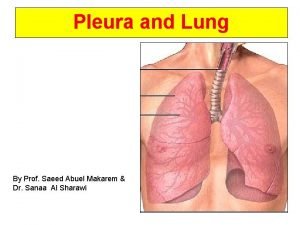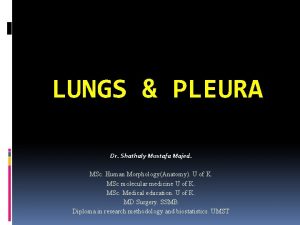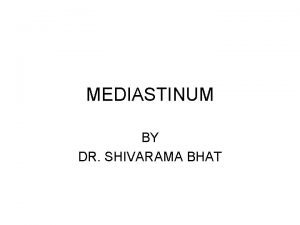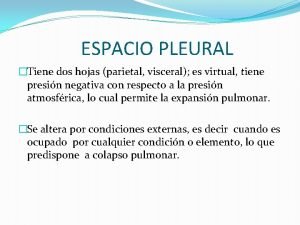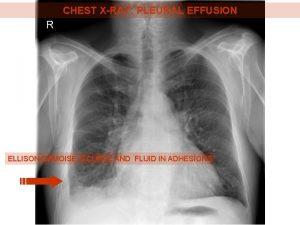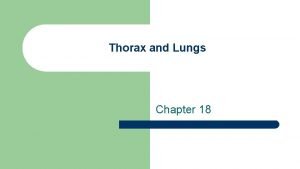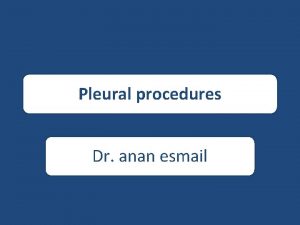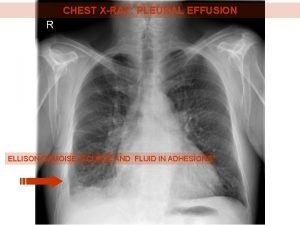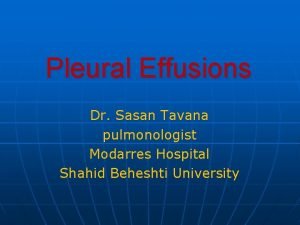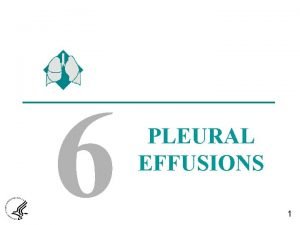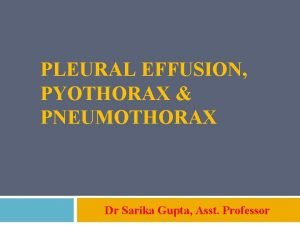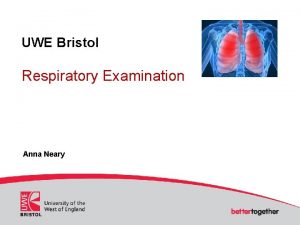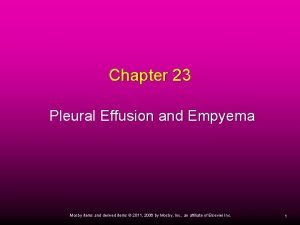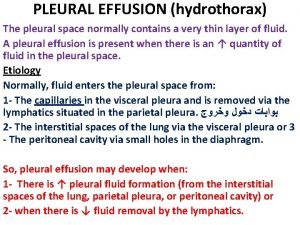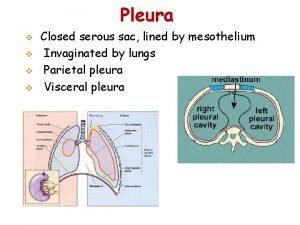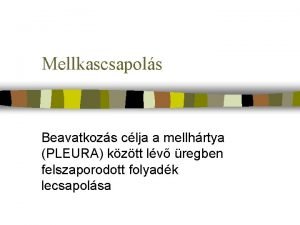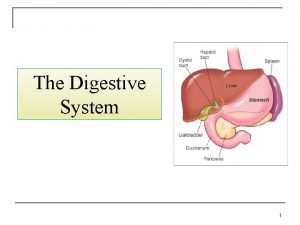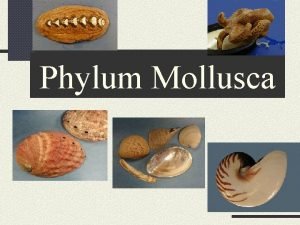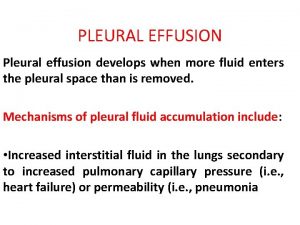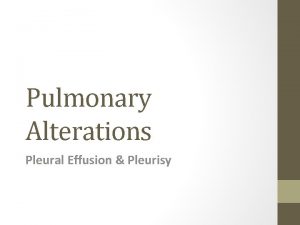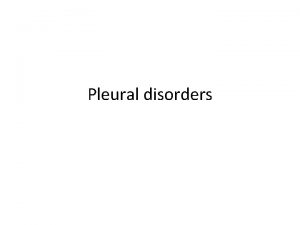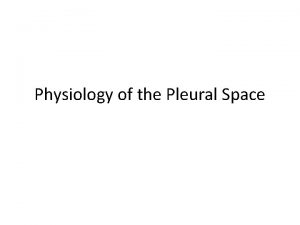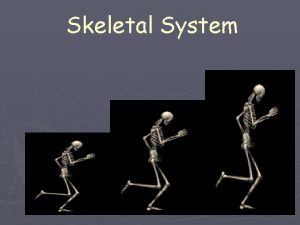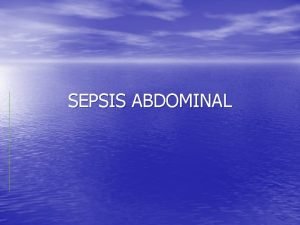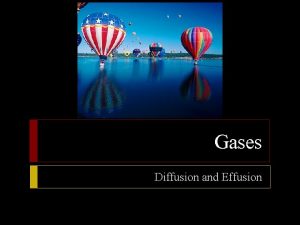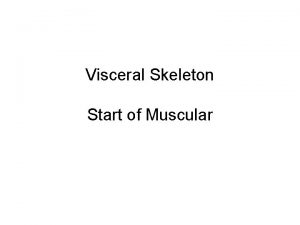Pleural Effusion PLEURA 2 Parietal pleura Visceral pleura





































- Slides: 37

Pleural Effusion

PLEURA 2

Parietal pleura Visceral pleura , and ribs. envelope all surfaces of. Hilum where pulmonary vessels, bronchi, and nerves enter the lung tissue, the parietal pleura is continuous with the visceral pleura.

PLEURAL EFFUSION Normally the pleural space contains: • • • 3. 5 to 7. 0 ml of clear liquid low protein content small number of mononuclear cells Pleural effusion: presence of large amount of fluid in the pleural space irrespective of the underlying causes

PLEURAL FLUID FORMATION AND ABSORTION • The rate of fluid formation is 0. 02 ml/kg/hour. • The rate of fluid clearance is 0. 2 ml/kg/hour.

Starling’s Law Fluid movement Starling’s law : L. A [ (PCAP – PPl) – ( CAP – Pl) ] L: Filtration coefficient A: Surface area Cap: Capillary Pl: Pleural 6

Pleural Fluid Formation and Absorption Intercostal Pleural Space Bronchial Micro vessels VEIN ARTERY ? LYMPHATICS TO MEDIASTINAL NODES PLEURAL FLUID STOMA PLEURAL SPACE PARIETAL PLEURAL VISCERAL PLEURAL

Development of Pleural Effusion pulmonary capillary pressure (CHF) capillary permeability (Pneumonia) intrapleural pressure (atelectasis) plasma oncotic pressure (hypoalbuminemia) pleural membrane permeability (malignancy) lymphatic obstruction (malignancy) diaphragmatic defect (hepatic hydrothorax) thoracic duct rupture (chylothorax)

Other causes of pleural effusion: nephrotic syndrome, TB, collagen vascular disease, urinothorax, SVC syndrome, Meigs syndrome, rheumatoid arthritis, pancreatitis, yellow-nail syndrome, drugs

Symptoms key symptom shortness of breath Fluid filling the pleural space makes it hard for the lungs to fully expand, causing the patient to take many breaths so as to get enough oxygen. If parietal pleura is irritated mild pain or a sharp stabbing pleuritic type of pain. symptom Some patients will have a dry cough.

Symptoms Occasionally ------> no symptoms at all. n This is more likely when the effusion collects gradually n Chest examination will reveal stony dullness, and decrease/absent breath sounds

Pleural Effusion n Pleural effusion is an abnormal accumulation of fluid in the pleural space. The 5 major types of pleural effusion are: Transudate, n Exudate, n Empyema, n Hemorrhagic pleural effusion or hemothorax and n Chylous or chyliform effusion. n

Evaluation n History: dyspnea pleuritic chest pain cough fever hemoptysis wt. loss trauma hx cancer cardiac surgery Physical: Dullness to percussion Decreased breath sounds Absent tactile fremitus n

Causes of Pleural Effusion Other causes of pleural effusion: nephrotic syndrome, TB, collagen vascular disease, urinothorax, SVC syndrome, Meigs syndrome, rheumatoid arthritis, pancreatitis, yellow-nail syndrome, drugs Light. NEJM 2002; 346: 1971 Annual incidence in the US

Chest Xray

PA Chest X-Ray Lateral decubitus

Pleural effusion

Pleural effusion

Thoracentesis

Indications for thoracentesis Effusions larger than 1 cm height of unknown origin n No need for thoracentesis for patient with obvious cause (CHF with bilateral effusions). However: n n In heart failure: febrile/pleuritic pain, unilateral, no cardiomegaly, no response to diuresis

Pleural fluid analysis Appearance Bloody Cloudy Putrid odor Hct <1% not significant, 1 -20%= CA, PE, Trauma >50% serum Hct = hemothorax trig level >110 mg/dl = chylothorax stain and culture = infection? Transudate vs Exudate?

Exudate v Transudate Patient’s serum protein is normal n Pleural protein is less than 25 g/l =Transudate n Pleural Protein more than 35 g/l. = Exudate n If not, Light’s criteria

Light’s Criteria Pleural fluid is exudate if one or more: Pleural fluid protein: serum protein > 0. 5 Pleural fluid LDH: serum LDH > 0. 6 Pleural fluid LDH > 2/3 upper limit nl serum LDH Transudate Exudate CHF Pneumonia Cirrhosis Malignancy Nephrotic syndrome Pulmonary Embolism

Exudative Effusion n Cell count - Neutrophil predom acute pleural process (pneumonia, PE) - Lymphocytic predom chronic process (Cancer, TB, CABG) Culture/stain- infected fluid n Glucose- low level (<60 mg/dl)(pneumonia, CA) n Cytology- malignancy (non-dxthoracoscopy) n p. H- parapneumonic <7. 2 -must drain fluid malignant < 7. 2 –poor prognosis n

EXUDATIVE EFFUSIONS n Lymphocytic (> 50%) n n CA (30 -35%) TB (15 -20%) Sarcoidosis n n n Empyema Parapneumonic Rheumatoid Pulmonary infarction PMN or Lymphocytic n n n PE Conn tissue disease Post-cardiac injury Eosinophilic (> 10%) n n n PMNs n n n Trauma PTX CA Asbestos, parasites Pneumonia RBC > 100, 000/mm n n n CA Trauma Pulmonary infarction

EXUDATIVE EFFUSIONS Other Tests n Suspected TB n n n n Adenosine deaminase (> 50 IU/L) B 2 - microglobulin Lysozyme III (> 20 mcg/m. L) PCR (Sens 100%, Spec 95%) AFB (smear 10 -20%; cx 25 -50%) PPD Suspected Rheumatoid n n Pleural RF Low glucose n Suspected SLE n n Suspected Pneumonia n n Serum Complement Pleural ANA LE cells prep? p. H Suspected Pancreatitis n Pleural Amylase

Malignant Effusions n Clinical features suggestive of malignacy: Symptoms> 1 mo, absence of fever, blood-tinged fluid, chest CT suggesting malignancy n n n n Lung >breast > lymphoma/leukemia metastatic adenocarcinoma positive cytology 70% Lymphoma 25 -50% Mesothelioma 10% Squamous Cell Carcinoma 20% Sarcoma within pleura 25% Pleural fluid: bloody, lymphocytic, decreased or nl glucose and p. H, cytology

Treatment n Thoracentesis – then treat underlying disease n Uncomplicated pneumonia – antibiotics Hemithorax involved/empyema – tube thoracostomy +/- VATS n Malignant effusion- chest tube +/pleurodesis (sclerosants) VATS n

UNDIAGNOSED PLEURAL EFFUSIONS 15 -20% of effusions n Careful review of history, PE, meds, risk factors n Consider occult abdominal process n Consider PE n

UNDIAGNOSED PLEURAL EFFUSIONS n Cont’d Risk factors for TB or malignant effusion Weight loss > 4. 5 kg (10 pounds) n Fever > 38 C n Positive PPD n Large effusion (> 1/2 hemithorax) n < 95% lymphs in pleural fluid n n If ANY factor present, evaluate for TB, CA

BEYOND THORACENTESIS n Pleural Biopsy Most helpful in evaluating for TB n Limited utility for CA n n Thoracoscopy n Most helpful in evaluating for malignancy

Treatment n Thoracentesis – then treat underlying disease n Uncomplicated pneumonia – antibiotics Hemithorax involved/empyema – tube thoracostomy +/- VATS n Malignant effusion- chest tube +/pleurodesis (sclerosants) VATS n

Indications for Chest Tube Empyema n Complicated parapneumonic effusion PH <7. 2 n Hemothorax n Malignant effusion- chest tube +/pleurodesis (sclerosants) n


Pleural Biopsy Most helpful in evaluating for TB n Limited utility for CA n

Thoracoscopy

 Difference between exudate and transudate
Difference between exudate and transudate Visceral pleura
Visceral pleura Difference between right and left bronchus
Difference between right and left bronchus Adduction
Adduction Parietal pericardium
Parietal pericardium Gastrocolic ligament
Gastrocolic ligament Sonda pleural
Sonda pleural What is the peritoneal cavity
What is the peritoneal cavity Phases of deglutition
Phases of deglutition Parietal peritoneum visceral peritoneum
Parietal peritoneum visceral peritoneum Qual é a função do sistema digestório
Qual é a função do sistema digestório Ellis curve in pleural effusion
Ellis curve in pleural effusion Increase tactile fremitus
Increase tactile fremitus Pleural biopsy
Pleural biopsy Left lung
Left lung Exudate vs transudate
Exudate vs transudate Fluid in x ray
Fluid in x ray Tactile fremitus normal findings
Tactile fremitus normal findings Dr sasan beheshti
Dr sasan beheshti Hypersonority
Hypersonority Kerley b lines
Kerley b lines Normal pleural ldh
Normal pleural ldh Light criteria
Light criteria Concept map for mi
Concept map for mi Tactile fremetus
Tactile fremetus Pleural fluid
Pleural fluid Costophrenic angle
Costophrenic angle Causes of exudative pleural effusion
Causes of exudative pleural effusion Suprapleural membrane
Suprapleural membrane Costomediastinal recess
Costomediastinal recess Tenziós ptx
Tenziós ptx Pleura visceral
Pleura visceral Mellkaspunkció menete
Mellkaspunkció menete Peritoneum
Peritoneum Cerebrum vs cerebral cortex
Cerebrum vs cerebral cortex Autonomic reflex arc
Autonomic reflex arc Vas deferens
Vas deferens Taxonomy
Taxonomy
